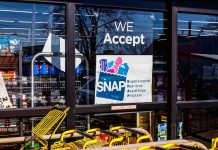(HealthyExaminer.com) – Did you know that there are programs available to help families with children afford nutritious food? These programs include meal service and food pantry services that allow families to take ingredients home to prepare healthy meals. You may already be aware of school nutrition programs that help provide lunch to children during the school day, but community organizations also offer weekend and summer programs to help families outside of school. Programs run by the federal government usually have income limitations for nutrition program eligibility while local non-profits may offer more lenient requirements.
National School Breakfast Program and National School Lunch Program
Low-income families can apply for free or reduced breakfast and lunch through their child’s school. This program is administered through the USDA in partnership with state agencies. Eligibility depends on family income or membership in particular categories. To qualify for free meals at school, families must earn less than 130% of the federal poverty guidelines. For lower-cost meals, which can’t cost more than $0.30 for breakfast and $0.40 for lunch, families must earn between 130-185% of the federal poverty guidelines. Children who receive other federal assistance will also qualify for free meals at school including children who are in a federally-funded preschool, those in foster care, and/or families who receive SNAP benefits.
It’s interesting to note that twice as many children receive school lunches as school breakfasts even though they have the same eligibility requirements. Children who qualify for free or reduced lunch costs also qualify for breakfast. These school meals meet nutrition requirements, and families can rest easy knowing that children are receiving healthy food during their school days. Breakfast provides a quarter of the nutritional needs for calories, proteins, and nutrients while lunch provides a third of those needs.
School Pantry Programs
School Pantry Programs are located on or near schools. Eligibility requirements are simple; typically, anyone living in the school district is eligible. Recipients for the school pantry program may include students who don’t qualify for free or reduced lunch, students who attend other schools, or even families without school-age children who live in the area and have unmet nutritional needs.
School pantries usually have set operating hours weekly or monthly. Families may even be able to select items from shelves or receive pre-packaged boxes from the program. Interested families should check with their local school district to find out more about local school pantry programs.
Backpack Programs
Feeding America and its partners run the Backpack Programs, which give students backpacks on Fridays or the day before a school break. The backpacks contain food ingredients for healthy meals over the weekend. Backpacks could be filled with cereal, granola bars, fruits, vegetables, and convenient meals like macaroni and cheese.
Some Backpack organizations partner with the school system to distribute backpacks at school or at other pickup locations in the community. Eligibility requirements may vary, but backpacks are often available to those who qualify for school breakfast and lunch. Families can contact their local school district or food bank to find the nearest available backpack program.
Kids Cafe
Kids Cafe programs are designed to provide after-school snacks and dinners for children living in low-income areas. These programs are run by local organizations and individual schools. Eligibility requirements may vary. Some programs may extend eligibility to all children in the service area while others require registration through the school system. Kids Cafe programs may also offer after-school activities or other services, and interested families should contact their local school district to inquire about Kids Cafe programs in the area.
School Meal Pickups
During the pandemic, many students were eligible for meal pickup. Some communities may still offer this benefit when schools are closed, operating remotely, or using a hybrid model. Schools that have returned to a normal operating schedule likely no longer offer meal pickup. For instance, Philadelphia closed meal pickup sites in March 2022 due to low pandemic case numbers but will resume the program if case numbers increase.
Summer Meal Programs
For families who rely on school meal programs, summer breaks can offer nutritional and financial challenges. Summer meal programs are designed to assist families in overcoming this challenge. These programs are run by the USDA and local food banks. There’s no need to register in advance or meet income qualifications. Individuals ages 18 and younger qualify for available summer meal programs.
Because these programs are individually run rather than managed at a federal level, finding them can be a challenge. Families using a Backpack or School Pantry program can often inquire there. Families can also contact the USDA hotline at 1-866-348-6479 to find available programs.
SNAP and TANF
There are also nutrition assistance programs that aren’t specific to schools, such as SNAP (Supplemental Nutrition Assistance Program) and TANF (Temporary Assistance for Needy Families). SNAP is also run by the USDA Food and Nutrition Service program, and eligibility requirements are based on family income and assets. Families apply for these benefits through their state’s agency. Eligible families receive money for groceries on an EBT debit card.
Families can also apply for TANF benefits through their local state agency. TANF eligibility requirements are based on income and assets as well, but adults applying for the program also need to be actively searching for employment. TANF benefits are temporary and available for a limited time, which is not to exceed five years over the course of a lifetime.
Federal, state, and community programs exist to help connect children with the healthy nutrition they need to learn and grow. The programs reviewed here are a starting point for families looking for assistance to meet their nutritional needs. To learn more about available resources, contact your local schools, nutritional organizations, and non-profit organizations to find out which programs may be right for you and your family.
Copyright 2023, HealthyExaminer.com












